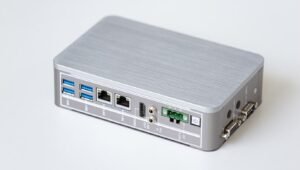What Is Stored in a Computer
Computers are complex machines that store and process vast amounts of data. These electronic devices are capable of storing various types of information, including documents, images, videos, and software. Understanding what is stored in a computer is essential for appreciating the functionalities it offers and the ways it impacts our lives.
Key Takeaways
- Computers store various types of data including documents, images, videos, and software.
- Data is stored in computer memory, which can be classified into primary and secondary storage.
- Primary storage, such as RAM, is volatile, while secondary storage, like hard drives, is non-volatile.
- Software programs, operating systems, and user files are commonly found in computer storage.
Computer memory is the place where data is stored. It can be classified into two main types: primary and secondary storage. Primary storage, often referred to as RAM (Random Access Memory), is a temporary form of memory that is used to store data that is actively being used by the computer. When the computer is powered off or restarted, the data in RAM is lost. Secondary storage, on the other hand, is non-volatile and retains data even when the computer is turned off.
The Types of Data Stored in a Computer
Computers store a wide range of data, including:
- Documents: Computers are commonly used for creating, editing, and storing documents, such as text files, spreadsheets, and presentations.
- Images: Digital photographs, graphics, and other visual files are stored in a computer’s memory or external storage devices.
- Videos: From home videos to high-definition movies, computers can store video files of various formats and resolutions.
| Data Type | Approximate Size |
|---|---|
| 1 page of text | 2 kilobytes |
| 1 high-resolution image | 10 megabytes |
| 1 minute of HD video | 250 megabytes |
Another essential aspect of a computer’s storage is the presence of software. Operating systems, such as Windows and macOS, are stored in a computer’s memory and enable the computer to function. Additionally, various software programs, both third-party and user-installed applications, occupy storage space.
Storage Devices
To store and retrieve data, computers utilize different types of storage devices:
- Hard Disk Drives (HDD): These magnetic storage devices consist of platters that spin at high speeds while an arm with read/write heads moves across to access data. Hard drives offer large storage capacities and are commonly used in desktop computers and servers.
- Solid-State Drives (SSD): SSDs use flash memory technology to store data. They are faster, more durable, and consume less power than traditional hard drives. SSDs are commonly found in laptops and many modern desktop computers.
- External Drives: External hard drives and SSDs connect to the computer through USB ports, providing additional storage capacity.
| Storage Device | Advantages |
|---|---|
| Hard Disk Drive | High storage capacity, lower cost per gigabyte |
| Solid-State Drive | Faster data access, more durable, efficient |
| External Drive | Portable, convenient for backups |
Cloud storage is another popular method of storing data, where files are stored on remote servers accessed over the internet. This allows users to access their data from different devices and locations.
With the increasing amounts of data stored and the advancements in storage technologies, computers continue to revolutionize the way we store and access information. From personal documents to vast databases, computers play a crucial role in both our personal and professional lives.
Wrap Up
Understanding what is stored in a computer is fundamental to comprehend its capabilities and impact. Computers store a range of data types including documents, images, videos, and software. This data is stored in both primary and secondary storage. Primary storage, like RAM, is volatile, while secondary storage, such as hard drives, is non-volatile. Additionally, computers use various storage devices like HDDs, SSDs, and external drives to store and retrieve data. With the continuous advancements in computer storage and cloud technologies, data management becomes critical in our increasingly digital world.

Common Misconceptions
Misconception 1: Computers store information permanently
Many people believe that once information is stored in a computer, it will remain there permanently. However, this is not true. Computers store data in several forms, including temporary and permanent storage. Some common misconceptions regarding this are:
- Data saved on a computer will never be lost.
- Data can be retrieved even if the computer is destroyed.
- Computers have infinite storage capacity.
Misconception 2: Computers store information in a physical format
Another common misconception is that computers store information in a physical format, similar to how we store files in drawers. However, computers use digital storage methods, where data is represented in binary code. Some misconceptions around this topic are:
- Data is stored as tiny electronic components within the computer.
- Data exists as physical files inside the computer’s hard drive.
- Data storage on a computer is similar to storing CDs or floppy disks.
Misconception 3: Computers store everything on the internet
Many people believe that computers store everything that exists on the internet. However, this is not the case. Computers only store data that we input or download from the internet. Some common misconceptions regarding this are:
- Every website visited is stored on the computer.
- Computers have access to all information on the internet, regardless of security or privacy settings.
- All downloaded files are permanently stored on the computer.
Misconception 4: Computers can store thoughts or consciousness
Another misconception is that computers have the capability to store thoughts or consciousness. While computers can process and store information, they cannot replicate the complex nature of human thought or consciousness. Some misconceptions related to this are:
- Computers can store human memories and emotions.
- By uploading our brain into a computer, we can achieve immortality.
- Computer storage can replicate human decision-making processes.
Misconception 5: All data stored on a computer is easily accessible
Lastly, there is a misconception that all data stored on a computer is easily accessible by anyone. In reality, data can be protected with encryption, passwords, and other security measures. Some common misconceptions related to this are:
- All files stored on a computer can be accessed by anyone who has physical access to it.
- Deleted files can always be recovered from a computer’s storage.
- Information stored in the cloud is not subject to privacy or security risks.

The CPU
The Central Processing Unit (CPU) is often referred to as the “brain” of a computer. It is responsible for executing instructions and performing calculations. The following table provides interesting details about the CPU.
| Fact | Data |
|---|---|
| Number of transistors in a modern CPU | Billions |
| Speed of the world’s fastest CPU | 5.3 GHz |
| First commercially available CPU | Intel 4004 (1971) |
Primary Memory
Primary memory, also known as RAM (Random Access Memory), stores data that the CPU requires for immediate processing. Explore some intriguing details about primary memory in the following table.
| Fact | Data |
|---|---|
| Capacity of an average modern RAM module | 16 GB |
| Speed of DDR4 RAM | 3200 MHz |
| Total volume of data processed by global RAM consumption per year | Over 2.5 exabytes |
Secondary Storage
Secondary storage devices, such as hard disk drives (HDD) and solid-state drives (SSD), are used for long-term data storage. The table below presents fascinating information about secondary storage.
| Fact | Data |
|---|---|
| World’s largest hard drive capacity | 20 TB |
| Data transfer rate of an average SSD | Up to 550 MB/s |
| Number of floppy disks needed to store 1 GB of data | Over 7000 |
Operating Systems
An operating system (OS) is a software that manages computer hardware and software resources. The following table showcases some intriguing facts about different operating systems.
| Fact | Data |
|---|---|
| Longest commercially supported OS | Windows XP (2001-2014) |
| Popularity of Linux-based Android OS | Runs on over 2.5 billion devices |
| Shortest time taken for an OS to become the most widely used | 6 months (Windows 10) |
Computer Peripherals
Peripherals are external devices connected to a computer, carrying out specific functions. Discover some intriguing facts about computer peripherals in the table below.
| Fact | Data |
|---|---|
| World’s fastest gaming mouse | Over 400 inches per second |
| Highest-resolution consumer monitor | 4K (3840 x 2160 pixels) |
| Number of keys on a standard computer keyboard | 101 |
Computer Networks
Computer networks are interconnected systems that allow computers to communicate and share resources. The following table presents captivating facts about computer networks.
| Fact | Data |
|---|---|
| World record for fastest internet speed | 178 terabits per second |
| Average global internet user penetration rate | Over 60% |
| Number of unique IPv4 addresses available | 4.3 billion |
Computer Graphics
Computer graphics involve generating and manipulating visual content using computers. Dive into the fascinating world of computer graphics with the following table.
| Fact | Data |
|---|---|
| Highest grossing animated film of all time | Avatar ($2.8 billion) |
| Number of triangles used to render characters in a video game like Fortnite | Over 50,000 |
| Year of the first computer-animated feature film | 1995 (Toy Story) |
Computer Security
Computer security refers to protecting computer systems and data from unauthorized access. Explore eye-opening details about computer security in the table below.
| Fact | Data |
|---|---|
| Average cost of a data breach | $3.86 million |
| Most common passwords people use | 123456, password, 123456789 |
| Percentage of worldwide emails classified as spam | Over 50% |
Artificial Intelligence
Artificial Intelligence (AI) involves developing computer systems that can perform tasks requiring human intelligence. The following table reveals captivating facts about AI.
| Fact | Data |
|---|---|
| Number of AI developers globally | Over 23 million |
| World’s fastest AI supercomputer | Sunway TaihuLight (93 petaflops) |
| Year of the first AI-powered chess victory | 1997 (Deep Blue) |
In the vast realm of computers, numerous fascinating aspects contribute to their functionality and impact on our lives. From the powerful CPU functioning as the brain to the fascinating world of artificial intelligence, each element plays a vital role. While CPUs contain billions of transistors and primary memory processes exabytes of data, secondary storage devices store massive amounts of information. Operating systems, computer peripherals, computer networks, computer graphics, computer security, and artificial intelligence further enrich the ever-expanding world of computing. With constant advancements, we remain captivated by the astonishing capabilities of computers.
Frequently Asked Questions
What is stored in a computer?
A computer stores various types of data, including files, applications, operating systems, and settings.
How does a computer store data?
A computer uses various storage devices such as hard drives, solid-state drives (SSDs), and random-access memory (RAM) to store data. Each storage device has its own way of retaining information.
What is stored in the hard drive of a computer?
The hard drive of a computer stores the operating system, application software, user files, and other data. It is a non-volatile storage device, meaning the data remains even when the computer is turned off.
What is stored in the RAM of a computer?
The RAM (Random Access Memory) of a computer is a volatile type of storage that temporarily stores data that is actively being used by the computer’s programs and operating system. It provides fast access to data, allowing the computer to run programs efficiently.
What is stored in the ROM of a computer?
The ROM (Read-Only Memory) of a computer stores permanent instructions necessary for the booting process and hardware initialization. It contains firmware and basic programs that are not meant to be modified by users.
What is stored in cache memory?
Cache memory is a small, extremely fast storage located directly on the computer’s processor. It stores frequently accessed data, instructions, and program results to speed up the overall performance of the computer.
Can a computer store personal files and documents?
Yes, a computer can store personal files and documents such as text documents, spreadsheets, images, videos, and music files. These files are typically saved in specific folders on the computer’s storage devices.
Can a computer store programs and applications?
Yes, a computer can store programs and applications, which are software designed to perform specific tasks. These applications are typically installed on the computer’s storage devices, such as the hard drive or SSD.
Can a computer store internet browsing history?
Yes, a computer can store internet browsing history. Browsers often save information related to websites visited, cookies, cached files, and other browsing details. However, users have the option to clear browsing history to maintain privacy.
What steps should be taken to protect data stored in a computer?
It is essential to take measures to protect the data stored in a computer. This includes regularly backing up important files, using secure and updated antivirus software, employing strong passwords, enabling firewalls, avoiding suspicious downloads or links, and keeping the operating system up to date.




